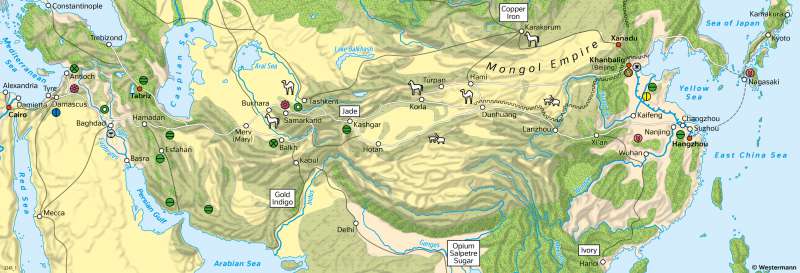Central Asia - The Silk Road in the age of Marco Polo (1254–1324)
Geopolitics
978-3-14-100890-6 | Page 119 | Ill. 4

Overview
The Silk Road between China and the eastern shore of the Mediterranean is one of the most famous trade routes in history. Primarily an important trade route, it also served an intensive cultural exchange. Antioch or Palmyra and Beijing were the starting and end points of a system of routes that stretched over thousands of kilometres. They led from China through the Takla Makan desert, over the high Pamir mountains, through Persia and then to Syria. Silk was the eponym of these trade routes, but numerous other precious goods were also transported.
Marco Polo travelling the Silk Road
The history of the Silk Road dates back to the 3rd century, when rulers of the Chinese Han Dynasty sought to connect to the existing trade routes of Central, West and South Asia, from which regular trade contacts between China and the Middle East gradually developed. Camel caravans carrying silk and perfume, spices, precious stones, and glassware crossed the snow-covered slopes of the Pamirs and the dry heat of the desert areas of the Tarim Basin. It probably took the traders two years to get there and back, according to some sources even longer. Trade, which reached a peak in the 7th century, brought economic prosperity to many cities along the Silk Road.
In the late High Middle Ages, there were contacts between the Christian West and the Mongol empires because the Pope considered the Mongols to be useful allies in the fight against Islam. Several times, clergymen were sent on diplomatic missions to Asia. The most famous traveller to Asia in this era was the Venetian merchant Marco Polo (1254-1324). In 1271, Polo accompanied his father and uncle on a journey to Central Asia and northern China. Via Baghdad, Iran and the Pamir Mountains, they first reached northern China and finally Chanbelik, today's Beijing. There Marco Polo gained the trust of Kublai Khan (1259-94), the founder of the Yüan dynasty, on whose behalf he made numerous journeys through China and acted as governor of the city of Hangzhou. In 1295, Marco Polo returned to his Italian homeland after a three-year journey via Iran, Armenia and Trapezunt. His travelogue about the culture and geography of the Far East had a great influence on the world view of the late Middle Ages.
<>With the discovery of new sea routes to India, Southeast Asia and East Asia, the Silk Road lost its importance for long-distance intercontinental trade.



